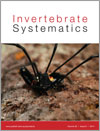IS14030A molecular phylogenetic approach to the New Zealand species of Enantiobuninae (Opiliones : Eupnoi : Neopilionidae)
The New Zealand long-legged harvestmen appear to show a striking difference in the size and coloration of males and females, and between males of the same species. Here we report the first study using DNA data from these charismatic animals to understand the relationships among the different species and attempt to solve the puzzle of assigning different-looking females and males to the same species. The results show which females and males belong to the same species, and that in fact, there are more than one kind of male for each species.




